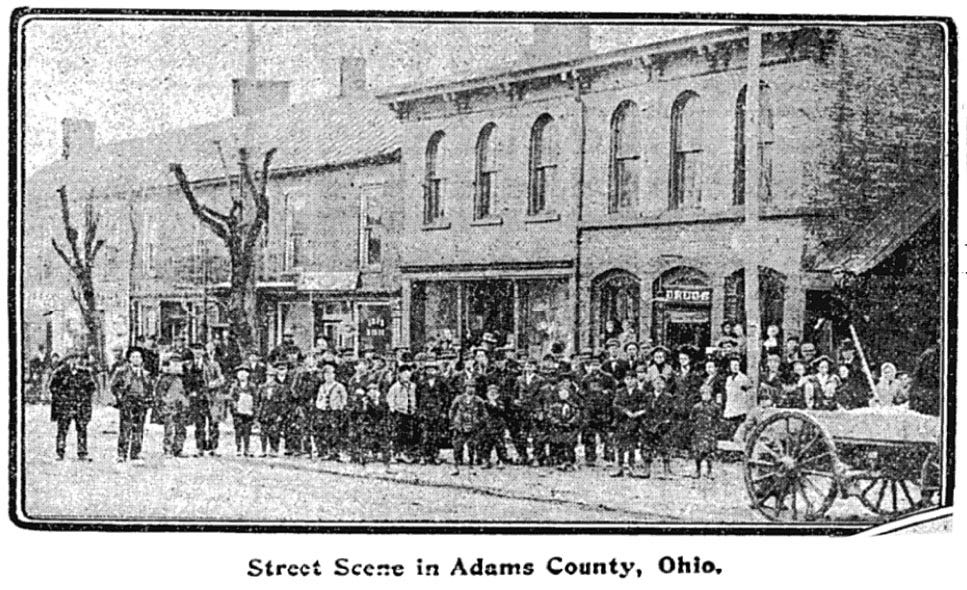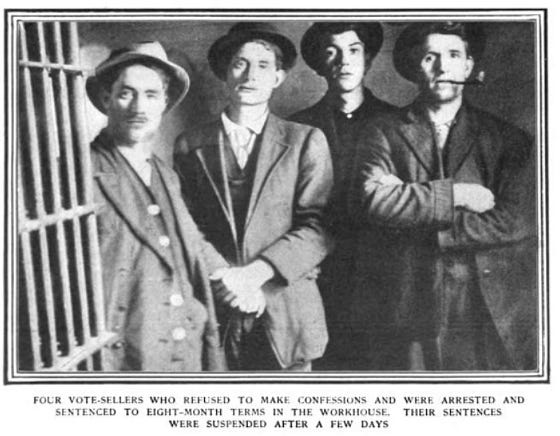The kind of voter fraud Donald Trump pretend-warns people about doesn’t really happen. (But you knew that, of course). However, there was once a voter fraud scandal in the United States so large that when it was all over, 1,679 people were convicted. It was a national story, covered by publications from the New York Times to Cosmopolitan. So why have you never heard about this? Because it happened more than 100 years ago and has rarely been mentioned since.
The story takes place in Adams County, Ohio, where election season was an open market and votes were sold to whichever candidate would pay the most. Buying a vote could cost anywhere from a drink of whiskey to $25, with most people pricing their votes somewhere in between. And the money flowed. (So, presumably, did the whiskey). In 1887, for example, two politicians spent $30,000 between them — nearly $820,000 in today’s dollars — buying votes for their party in Adams County.
When I say “open market,” I really mean it. The people of Adams County would literally stand on a soap box in front of the court house declaring their votes available to the highest bidder. In the early years of vote-buying, politicians and their agents would distribute cash in exchange for just a promise of a vote. Eventually things became more sophisticated so that after the sale, a voter would go into the voting booth and then show their ballot to a judge. The judge would verify the vote and give a signal for a worker to pay the man.
And of course it was always a man because women couldn’t vote. By some accounts, the women of Adams County were opposed to the practice of vote-selling from the beginning. But there are stories of women who still got involved. Mothers sold the votes of sons and husbands. Sisters sold their brothers’ votes. It was fun for the whole family!
Young men growing up in Adams County eagerly awaited their 21st birthday so they could sell their vote and make a little money. It was a reliable bit of income you could use to buy yourself something special. And why not? When your father, teacher, doctor, and everyone else has been selling their votes since before you were born, why would you think it’s anything but normal?
This went on for decades. In fact, it was estimated that over thirty years there were only four “honest elections” in Adams County.
Finally, someone developed a conscience. In December, 1910, a local federal judge named A. Z. Blair, who himself had bought votes in the past, decided it was time to put an end to this. So he convened a grand jury. The purpose wasn’t to do any sort of real investigation — everybody knew what was happening — or even to punish anyone too harshly, but just to end this practice for good.
So Judge Blair brought in several hundred of the vote buyers and offered them immunity from prosecution if they would provide the names of all the vote sellers. And then he let word get out that he had a list.
The judge put notices in newspapers announcing that he knew who sold their votes, and indictments would be coming. But if you came in voluntarily and confessed, you would be treated with leniency.
People came to confess by the hundreds. They flocked to the court house in the hope of getting off easy. As the New York Times reported:
Some of them walked miles to get to court. Hundreds arrived at a time… They arrived in automobiles, in wagons drawn by horses, mules, and oxen, on horseback and afoot. They were rich and poor, educated and illiterate, laborer and merchant, men with police records and church pewholders…
Mrs. Lawrence Furtwanger, 65 years old, walked fifteen miles into town from her home in Turn Creek on behalf of her invalid son and husband. She pleaded guilty for both of them.
The typical sentence was a fine of $25, plus a six month sentence in a workhouse, plus 5 years of disenfranchisement. But the workhouse sentence and $20 of the fine were both suspended, leaving people paying $5 in fines ($136 in today’s dollars) and losing their right to vote for 5 years.
In the end, one fourth of the voting population of Adams County was convicted.
It was controversial that only the vote sellers were punished and not the vote buyers, and Judge Blair received criticism and even threats over this. But he mostly received praise for returning Adams County to a place of honesty.
Theodore Roosevelt had been out of office for about a year at this point and was now associate editor of a magazine called The Outlook. He wrote an editorial in the aftermath of the scandal in which he said (emphasis original):
The people are good Americans who went wrong, and then themselves corrected the wrong; and until we, who live in other neighborhoods, ourselves correct the wrongs of our own neighborhoods in similarly resolute fashion, we must make up our minds that they stand well above us when judged by the standards of decent citizenship.
Boodling
Your word of the day is boodling. Merriam-Webster defines it as “graft or fraud especially in politics” and it showed up a lot in my research for this story.
This Google ngram shows how use of boodling peaked around the time of this scandal. Use of voter fraud is also shown for comparison:
Source Material
Here is the material I drew from for my retelling of the Scandal of Adams County, all from 1910-1911 and all available to read online for free:
Seventeen Hundred Rural Vote-Sellers by Judge A. Z. Blair, McClure’s, November, 1911. This is the best article, by the judge himself.
A National Lesson from Adams County by Albert Shaw, The American Review of Reviews, February, 1911. This is where most of the photos above came from.
The Shame of Ohio by George Creel and Sloane Gordon, Cosmopolitan, October, 1911. The article was part of a 10-part series on corruption and misconduct called “What are you going to do about it?”
A County Where Selling Of Votes Is Universal, The New York Times Sunday Magazine, January 15, 1911. A full-page story recapping of all the events to that date. But they had previously run several stories covering the scandal as it unfolded.
Applied Good Citizenship by Theodore Roosevelt, The Outlook, November 11, 1911. This article is a response to the judge’s piece for McClure’s linked to above.
I discovered the scandal of Adams County in 2011 while writing Sunday Magazine, a project where I revisited the most interesting articles from the New York Times Sunday Magazine from 100 years ago each week. I’ve since handed the reigns of that project over to journalist and pun champion Jesse Rifkin, who continues it to this day. You should check it out.
A New Thing You Should Listen To
In my dreams I make videos as good as Adam Lisagor’s. And one day I hope that my newsletter will be as good as Noah Kalina’s. But one thing I have zero aspirations to ever do is buy all the junk that’s advertised on Instagram just to see how good or bad it is. Luckily, I won’t ever have to because Adam and Noah have teamed up to do exactly that for their new podcast called All Consuming.
Here they are to tell you about it:
That’s it for this week. If you’re new here, check out the archive. Follow me on Twitter. Vote early. And remember: No boodling.
See you next week.
David












